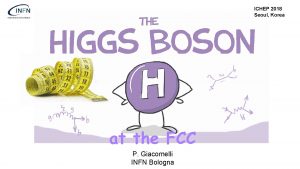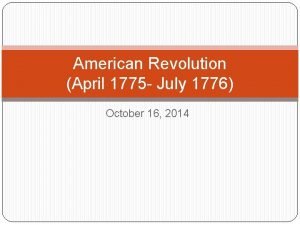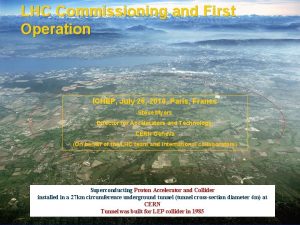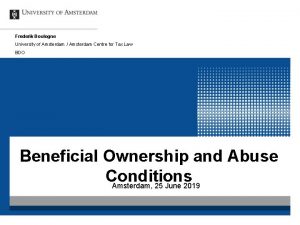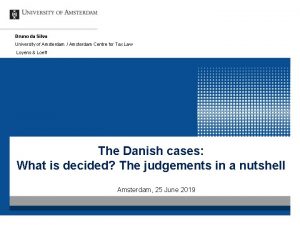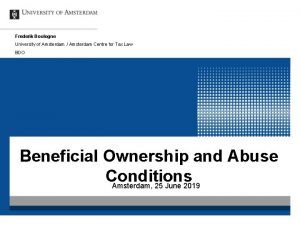ICHEP 2002 Amsterdam July 23 31 2002 Top

















- Slides: 17

ICHEP 2002, Amsterdam July 23 - 31, 2002 Top Quark Physics at the Tevatron Ia Iashvili University of California, Riverside For the CDF and DØ Collaborations • • Introduction Latest results from Run 1 New results from Run 2 Summary and prospects

Introduction • Top quark has a special place in the SM – – • The Yukawa coupling, Special role in EW symmetry breaking? 3 classes of signal in – – • – Discovered at Tevatron in 1995 CDF, PRL 74, 2626 (1995) DØ, PRL 74, 2632 (1995) production: Dilepton — 2 high-PT leptons, 2 b-jets, large ETmiss — BR(ee , mm, em) = 5% Lepton+Jets — 1 high-PT lepton, 4 jets (2 b’s), large ETmiss — BR(e, m+jets) =30% All-hadronic — 6 jets (2 b’s) — BR=44% • Another mechanism — single-top production via EW interaction: • Wealth of information extracted with ~100 events per experiment based on ~110 pb-1 Run 1 data Top quarks have been observed in pair production through strong interaction: ICHEP 2002 Ia Iashvili 2

Top Physics in Run 1 • Xsection and top mass – CDF: (Phys. Rev. D 64 03022, 2001) – DØ: – CDF+ DØ: – in good agreement with theory (hep-ex/0205019, 2002) (Fermilab-TM-2084, 1999) CDF l+jets 76 events ICHEP 2002 Ia Iashvili 3

Top Physics in Run 1 • Studied top-antitop spin correlation using 6 dilepton events (DØ, Phys. Rev. Lett. 85, 256, 2000): • W helicity in top decays using dilepton and lepton+jets sample (CDF, Phys. Rev. Lett. 84, 216, 2000): – SM: K ~ 0. 9 – DØ : K > -0. 25 at 68% C. L. • – SM: – CDF: Branching ratio R=BR(t Wb)/BR(t Wq) and |Vtb| (CDF, Phys. Rev. Lett. 86, 3233, 2001): ICHEP 2002 • Top quark PT distribution (CDF, Phys. Rev. Lett. 87, 102001, 2001; DØ, Phys. Rev. D 58, 052001, 1998) • All measurements in agreement with the Standard Model Ia Iashvili 4

Search for single top production in Run 1 • At Tevatron dominant single top production processes are: – – • Final state consists of W decay products plus jet(s) : – Searches are restricted to leptonicaly decaying W en, mn • Single top processes are harder to observe than production: – final states containing fewer jets suffer from a larger background – A priori no sensitivity expected in Run I data, unless new physics processes enhance production rate ICHEP 2002 • CDF and DØ have performed searches for s-channel and t-channel separately • CDF has also performed search for two single-top processes combined. Derived Xsection limit is: – Ia Iashvili s (single-t) < 14 pb at 95% C. L. (Phys. Rev. D 65, 091102, 2002) 5

Search for single top production in Run 1 • To separate two single-top processes consider non-overlapping W+2 jets samples: – – single-tag events -- dominated by t-channel double-tag events -- dominated by s-channel • In t-channel light-quark often is in the same hemisphere as the (anti)proton when (anti)top is produced • In double-tag events use Mlnb distribution to extract s-channel contribution • • CDF: single-tag W+2 jets events CDF: double-tag W+2 jets events 95% C. L. limits are set by CDF at: – – s(s-channel) < 18 pb s(t-channel) < 13 pb (Phys. Rev. D 65, 091102, 2002) 95% C. L. limits derived by DØ: – – s(s-channel) < 17 pb s(t-channel) < 22 pb (Phys. Lett. B 517, 282, 2001) ICHEP 2002 Ia Iashvili 6

Search for resonances in Run 1 • • Models with dynamically broken EW symmetry ( “Technicolor”) predict existence of top quark condensate X that can decay to pair, • Search for narrow resonance — reduce sensitivity to the model details ICHEP 2002 Use lepton + jets events. Fit observed distribution of to derive probability distributions of Nevents for signal, top pair, and other SM background processes. Ia Iashvili 7

Search for resonances in Run I • No statistically significant excess has been observed and therefore 95% C. L. limit has been derived on production Xsection assuming Gx=0. 012 Mx and Mt=175 Ge. V • For particular model of leptophobic topcolor (C. T. Hill and S. Parke, hepph/9911288) DØ excludes Mx< 560 Ge. V at 95% C. L. • Under the same assumption CDF has set lower limit of 480 Ge. V at 95% C. L. (Phys. Rev. Lett. 85, 2062, 2000) ICHEP 2002 Ia Iashvili 8

Tevatron Upgrade • • • New Main Injector and Recycler Ring Improved Antiproton source and Booster – Increase pbar yield – Increase luminosity • Increase number of bunches – Reduce number of interactions per crossing – Reduce bunch spacing Increase beam energy 900 980 Ge. V – Increase Xsections for interesting physics processes, e. g. by 30 -40% for top production: - from ~5 to ~7 pb for top pair, - from ~2. 4 to ~3 pb for single top Run 1 Run 2 a Run 2 b 0. 1 fb-1 2 fb-1 15 fb-1 Run 1 b Run 2 a Run 2 b #bunches 6 x 6 36 x 36 140 x 103 s (Te. V) 1. 8 1. 96 typ L (cm-2 s-1) 1. 6 x 1030 8. 6 x 1031 5. 2 x 1032 Ldt (pb-1/week) 3. 2 17. 3 105 bunch xing (ns) 3500 396 132 or 396 interaction/xing 2. 5 2. 3 4. 8 ICHEP 2002 Ia Iashvili Run 2 data taking started in spring 2001 9

Run 2 detectors • CDF upgrades – New Silicon Vertex Detector (SVX) and faster tracking drift chamber (COT) – New scintillating tile end-plug calorimeters – Increased hf coverage for muon detectors – New scintillator time of flight system • CDF DØ upgrades – New Silicon (SMT) and Fiber (CFT) trackers, placed in 2 T magnetic field – Calorimeter supplemented with the preshower detectors – Significantly improved muon system DØ Both detectors: - b-tagging capability through displaced vertices - Improved lepton identification systems • Entirely new DAQ and trigger systems to handle high event rate • Both CDF and DØ will replace Silicon detectors during 2004 shutdown — dictated by radiation damage. ICHEP 2002 Ia Iashvili 10

W e n candidates in Run 2 DØ data • W+jets and Z+jets are primary backgrounds to top Study these processes to asses detector performance before enough top events are detected • W Lint~7 pb-1 transverse mass spectrum in e + missing ET inclusive sample. QCD background derived from the data • Inclusive jet multiplicity in background subtructed W en sample — follows to linear in log law (Berends scaling) • With higher statistics and b-tagging requirement, enhancement at W+4 jets will indicate ttbar enj+jjj contribution ICHEP 2002 Ia Iashvili 11

W and Top candidates in Run 2 CDF data W mn events W tn events: Ntracks associated to t ICHEP 2002 Ia Iashvili 12

Z candidates in Run 2 data Z e+e- events DØ Z m+m- events ICHEP 2002 Ia Iashvili 13

b-tagging in Run 2 • b-tagging capability important to suppress background to top (W/Z+jets, QCD jets) • To tag b-jets exploit both techniques: – • a) soft lepton tagging (SLT); b) tagging with displaced vertices Soft Lepton Tagging: – – – B(b lnc)~20%, B(b c lns)~ 20% with l=e and m use both muons and electrons looking at PT relative to jet axis Muon tagging has been checked in data for bbbar decay studies • Impact Parameter Tagging: – – study di-jet events with and without muon di-jet event containing muon within d. R <0. 7 and PTrel>1. 5 Ge. V are enhanced in heavy flavour ~resolution ICHEP 2002 Ia Iashvili 14

b-tagging in Run 2 CDF B lifetime using J/y Expected : s=11 mm DØ unfoldi ng bea m width of 30 ± 3 mm Current performance is approaching Run 2 a design figure for both CDF and DØ ICHEP 2002 Ia Iashvili 15

Projection on measurement precisions • Two largest systematic errors in Mt are due to Jet Energy Scale (JES) and gluon radiation • In Run 2, Z bb decays will be used to limit JES — relies on L 2 Silicon Track Trigger • Gluon radiation correction will be constrained by comparing double-tag events with MC simulation • Expected accuracies by the end of Run 2 b : Top mass ~ 1. 4 Ge. V, W mass ~ 16 Me. V. Gives indirect constraint on higgs mass d. Mh/Mh ~25% (hep-ph/0202001, Snowmass Working Group on Precision EW measurements) ICHEP 2002 Ia Iashvili Tevatron projection 16

Summary • Successful top quark physics program at Run 1 – All measurements consistent with the Standard Model – But limited in statistics • We are entering exciting era of Run 2. Performance of upgraded CDF and DØ detectors are already close to expectations — many improvements relevant to top physics • Tevatron Run 2 will allow to precisely measure top quark properties. Signs of new physics could well show up first in these measurements. ICHEP 2002 Ia Iashvili 17
 Ichep 2018
Ichep 2018 Tender mean
Tender mean Sensory language definition
Sensory language definition Monday 13th july
Monday 13th july July 30 2009 nasa
July 30 2009 nasa The mysteries of harris burdick the harp
The mysteries of harris burdick the harp July 16 1776
July 16 1776 Malaga in july
Malaga in july July 2 1937 amelia earhart
July 2 1937 amelia earhart Ctdssmap payment schedule july 2021
Ctdssmap payment schedule july 2021 Hurrah for the fourth of july cartoon
Hurrah for the fourth of july cartoon Astronomy picture of the day 11 july 2001
Astronomy picture of the day 11 july 2001 Catawba indian nation bingo
Catawba indian nation bingo On july 18 2001 a train carrying hazardous chemicals
On july 18 2001 a train carrying hazardous chemicals Sources nso frenchhowell neill mit technology...
Sources nso frenchhowell neill mit technology... The mysteries of harris burdick captain tory
The mysteries of harris burdick captain tory June 22 to july 22
June 22 to july 22 Sergei korolev
Sergei korolev
